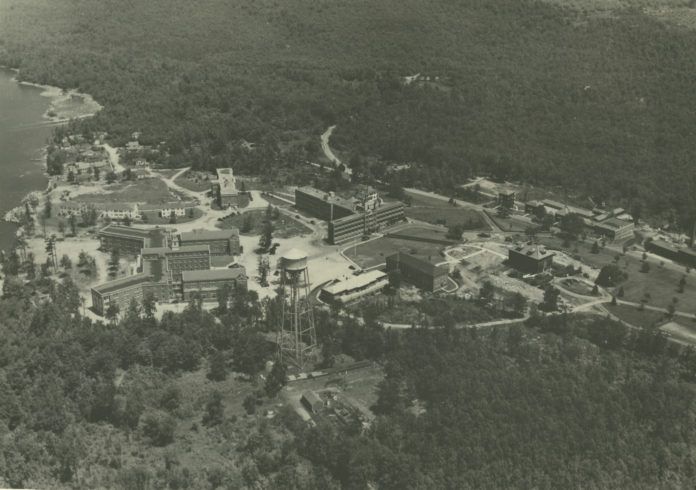Welcome to Burrillville Then & Now, where we take a glance back at how the town used to look, then show how the same space looks today.
With photos and information provided by the Burrillville Historic & Preservation Society, we look now at the history of the RI State Sanatorium for Consumptives – now known as the Zambarano unit of Eleanor Slater Hospital.
This history of the State Sanatorium is continued from the March feature.
During the first five years of the State Sanatorium’s operation, much of the surrounding land was cleared of woods and underbrush to provide garden space to grow vegetables. A hennery and a piggery were constructed by patients and employees. Land was cleared so that patients could go on picnics and quiet walks through pleasant groves. In 1907, the superintendent’s cottage was built. In 1914, a separate ward for children was constructed with 36 beds. At that time, a room was set aside as a schoolroom. Windows were kept open even during frigid winters and to keep warm, the children wore bag-shaped blankets over warm clothes.
In 1917, a new hospital to accommodate 153 people was constructed to care for those afflicted with advanced stages of tuberculosis at a cost of $!50,000. It was located 200 feet north of the older group of buildings and was connected to them by a tunnel. In 1919, X-ray equipment costing $2,800 was installed in the hospital.
In February of 1920, a heavy snowstorm left the sanatorium isolated for 11 days. Supplies were transported from Woonsocket on sleds, a distance of 17 miles, through snow 2-4 feet deep.
In September of 1927, construction of a new, fireproof Children’s Ward was begun. In 1936, a Nurses’ Home, called the Fitzpatrick House, was opened, and the following year, an addition to the hospital was added called the Danford House.

The 1938 hurricane caused extensive damage to some of the older buildings; 200,000 feet of lumber was cut from the sanatorium’s trees blown over in the storm.
Rules at Wallum Lake were strict, yet there were many freedoms. Patients who were able were allowed to plant and maintain a vegetable garden. In 1911, a moving picture projector was installed so the patients could watch silent movies. On Sundays during the summer, the Pawtucket Lodge of Elks performed a vaudeville show for the patients. Carpenters constructed platforms on the grounds for the performers. The various acts would rotate from stage to stage so that everyone could see every act. Patients enjoyed sailing on the lake, with men and women in separate boats, as they were not allowed to mix. Frequently, there were fishing cruises, and patients tried their luck for perch and bass. They also played cards, checkers, and chess, and were involved in crafts like leatherworking. There was a barber shop, radio room, post office and a store.
Men and women ate on separate sides of the dining room. A bell rang every morning at 5:45 a.m. to get everyone up. Half the patients ate at 6:30 a.m. and the other half at 7 a.m.
Besides bed rest and fresh air, there were medical treatments for tuberculosis. In 1912, the first pneumothorax treatments were given. With the acquisition of X-ray equipment and a fluoroscope in 1919, these treatments could be done more safely. In 1938, the first thoracoplasty was done, as well as other types of chest surgery. In 1940, all the original buildings were demolished except for the Administration Building. In the 1940s, antibiotic drugs were developed, which actually cured tuberculosis.
In 1955, the State Sanatorium was renamed the Dr. Ubaldo E. Zambarano Memorial Hospital. The doctor had been appointed superintendent of the State Sanatorium in 1939. In 1958, the hospital began to admit patients with diseases other than TB.
Betty Mencucci is president of the Burrillville Historic & Preservation Society.









